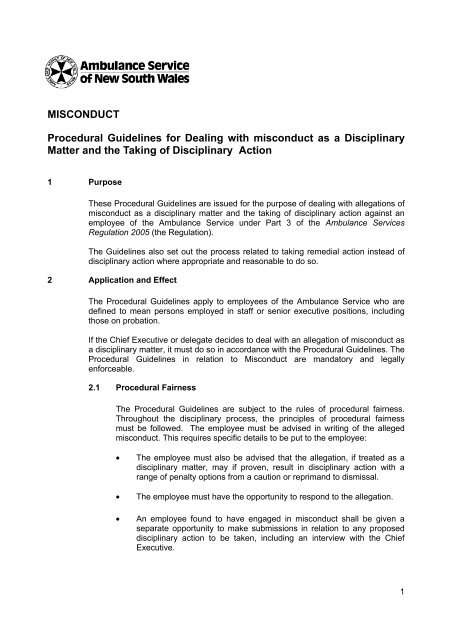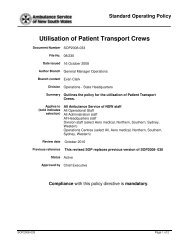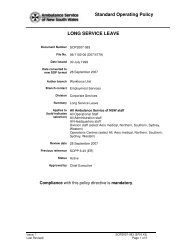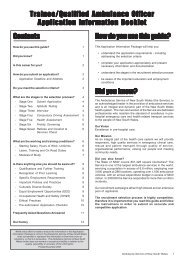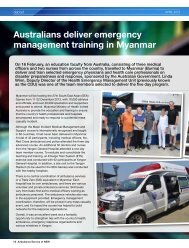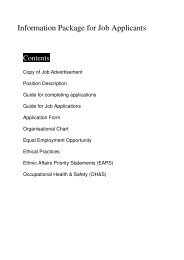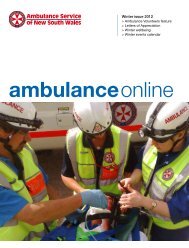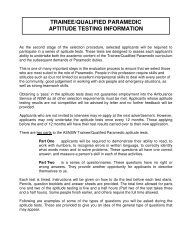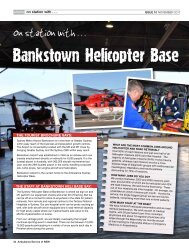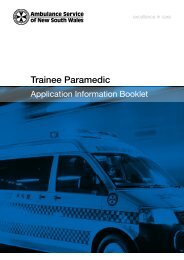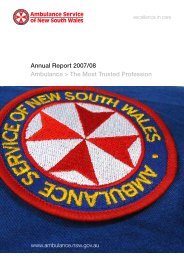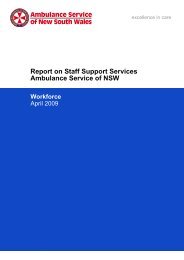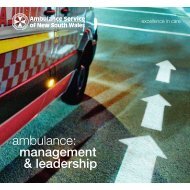Professional Conduct Guidelines - B. Misconduct, October 2006
Professional Conduct Guidelines - B. Misconduct, October 2006
Professional Conduct Guidelines - B. Misconduct, October 2006
Create successful ePaper yourself
Turn your PDF publications into a flip-book with our unique Google optimized e-Paper software.
MISCONDUCT<br />
Procedural <strong>Guidelines</strong> for Dealing with misconduct as a Disciplinary<br />
Matter and the Taking of Disciplinary Action<br />
1 Purpose<br />
These Procedural <strong>Guidelines</strong> are issued for the purpose of dealing with allegations of<br />
misconduct as a disciplinary matter and the taking of disciplinary action against an<br />
employee of the Ambulance Service under Part 3 of the Ambulance Services<br />
Regulation 2005 (the Regulation).<br />
The <strong>Guidelines</strong> also set out the process related to taking remedial action instead of<br />
disciplinary action where appropriate and reasonable to do so.<br />
2 Application and Effect<br />
The Procedural <strong>Guidelines</strong> apply to employees of the Ambulance Service who are<br />
defined to mean persons employed in staff or senior executive positions, including<br />
those on probation.<br />
If the Chief Executive or delegate decides to deal with an allegation of misconduct as<br />
a disciplinary matter, it must do so in accordance with the Procedural <strong>Guidelines</strong>. The<br />
Procedural <strong>Guidelines</strong> in relation to <strong>Misconduct</strong> are mandatory and legally<br />
enforceable.<br />
2.1 Procedural Fairness<br />
The Procedural <strong>Guidelines</strong> are subject to the rules of procedural fairness.<br />
Throughout the disciplinary process, the principles of procedural fairness<br />
must be followed. The employee must be advised in writing of the alleged<br />
misconduct. This requires specific details to be put to the employee:<br />
• The employee must also be advised that the allegation, if treated as a<br />
disciplinary matter, may if proven, result in disciplinary action with a<br />
range of penalty options from a caution or reprimand to dismissal.<br />
• The employee must have the opportunity to respond to the allegation.<br />
• An employee found to have engaged in misconduct shall be given a<br />
separate opportunity to make submissions in relation to any proposed<br />
disciplinary action to be taken, including an interview with the Chief<br />
Executive.<br />
1
• During any interview or inquiry that may be held in relation to the<br />
allegation, the employee may be represented by a solicitor, barrister or<br />
agent. All steps in the process are to be completed in a timely and<br />
expeditious fashion.<br />
3 Delegation - Chief Executive<br />
The Chief Executive is to deal with alleged misconduct by an employee.<br />
The Chief Executive may delegate the function to deal with allegations of misconduct<br />
as a disciplinary matter.<br />
In delegating the authority to deal with a disciplinary matter, the entire function<br />
including the tasks of determining whether the employee has engaged in misconduct<br />
and that of imposing the relevant disciplinary action or otherwise, should be<br />
delegated to the same person.<br />
In these guidelines, a reference to the ‘Chief Executive’ is to be read as to include a<br />
delegate.<br />
4 Timeframes<br />
The disciplinary process is to be complied within a timely and expeditious fashion.<br />
As a guide only, uncomplicated matters should generally be concluded after 10 to 12<br />
weeks from when the Chief Executive receives the initial allegation.<br />
Irrespective of the complexity of the matter, after 12 weeks from the receipt of the<br />
allegation, the Chief Executive is to advise the employee the subject of the<br />
allegation/s in writing, (see Sample letter 10) of the anticipated time for the current<br />
stage to conclude and outline the reasons for any delays to date or anticipated<br />
delays. Reasons for a delay may include:<br />
• the complexity of the matter<br />
• exceptional circumstances<br />
• a request for delay by an external investigating authority<br />
• availability of the employee.<br />
Similar advice is to be sent each subsequent 6 weeks after the first advice (see<br />
Sample letter 11).<br />
5 Terminology<br />
Disciplinary action means the penalty options defined at section 15(1) of the<br />
Regulation, namely, any one or more of the following:<br />
2
• dismissal from the Ambulance Service,<br />
• directing the employee to resign, or to be allowed to resign, from the<br />
Ambulance Service within a specified time, if the employee is on probation—<br />
annulment of the employee’s appointment,<br />
• except in the case of a senior executive officer—reduction of the employee’s<br />
classification or position,<br />
• a caution or reprimand.<br />
Disciplinary process means the process by which allegations of misconduct are dealt<br />
with as a disciplinary matter.<br />
Remedial action means the options defined at section 15(1) of the Regulation to deal<br />
with an allegation of misconduct as a remedial matter, namely:<br />
• counselling,<br />
• training and development,<br />
• monitoring the employee’s conduct or performance,<br />
• implementing a performance improvement plan,<br />
• the issuing of a warning to the employee that certain conduct is unacceptable<br />
or that the employee’s performance is not satisfactory,<br />
• transferring the employee to another position in the Ambulance Service that<br />
does not involve a reduction of the employee’s classification or position,<br />
• any other action of a similar nature.<br />
The “remedial” process means to adopt the remedial method with respect to the<br />
management of the matter, and to deal it by utilising one of the above outcomes.<br />
Unsatisfactory professional conduct in relation to an ambulance officer includes any<br />
of the following ( Clause 15 , Part 3 )<br />
• any conduct that demonstrates that the knowledge, skill or judgment<br />
possessed, or care exercised, by the ambulance officer in clinical practice is<br />
significantly below the standard reasonably expected of an ambulance officer<br />
of an equivalent level of training or experience<br />
• the ambulance officer’s failure without reasonable excuse to comply with a<br />
direction by the Ambulance Service to provide information with respect to a<br />
complaint under Part 3 of the Ambulance Services Regulation 2005 against<br />
the ambulance officer<br />
• any other improper or unethical conduct relating to the ambulance officer.<br />
6 <strong>Misconduct</strong><br />
<strong>Misconduct</strong> is specifically defined in the Regulation to include, but not be limited to<br />
the following:<br />
3
• A contravention (whether by act or omission) of any provision of the Act<br />
or the Regulation<br />
• Unsatisfactory professional conduct<br />
• Performance of duties in a manner justifying taking disciplinary action<br />
• Taking detrimental action (within the meaning of the Protected<br />
Disclosures Act 1994) against a person that is substantially a reprisal for<br />
the person making a protected disclosure within the meaning of that Act.<br />
• Taking any action against another person that is substantially a reprisal<br />
for an internal disclosure made by that employee.<br />
6.1 <strong>Misconduct</strong> – employee not on duty or prior to appointment as<br />
employee<br />
<strong>Misconduct</strong> may relate to an incident or conduct that happened while the<br />
employee was not on duty or before the employee was appointed to his or her<br />
position. In determining whether such conduct should be dealt with as a<br />
disciplinary matter the Chief Executive should have regard to the objects of<br />
Part 3 of the Regulation, that is:<br />
• To protect the health and safety of the public by providing mechanisms<br />
to ensure that employees of the Ambulance Service are fit to perform<br />
their duties,<br />
• To ensure that the public interest is protected,<br />
• To maintain appropriate standards of conduct and work-related<br />
performance in the Ambulance Service;<br />
• To protect and enhance the integrity and reputation of the Ambulance<br />
Service.<br />
The Chief Executive should consider:<br />
• Whether there is a relevant connection between the conduct and the<br />
employee’s position and duties<br />
• the context of the incident<br />
• the ‘age’ of the incident or offence<br />
• whether the incident was considered fundamental to the decision to<br />
employ /promote the employee<br />
• the employee’s employment record and history<br />
• whether remedial action is more appropriate<br />
• whether there are other options which might be applied such as referral<br />
to Employee Assistance Providers, alcohol and drug rehabilitation and<br />
anger management counselling.<br />
4
6.2 <strong>Misconduct</strong> – employee resigns or retires prior to action being taken<br />
Disciplinary action arising from misconduct can still be taken even though the<br />
employee has retired or resigned prior to the action being taken.<br />
Whether to pursue action after an employee has resigned or retired depends<br />
on a number of factors such as:<br />
• the seriousness of the allegation or incident<br />
• the practicality of maintaining contact with the former employee and<br />
• the cost/ benefit to the Service of pursuing the matter.<br />
Taking disciplinary action does not affect the former employee’s retirement or<br />
resignation or the relevant benefits and liabilities.<br />
6.3 Protected Disclosure<br />
A protected disclosure is a disclosure made within the meaning of the<br />
Protected Disclosures Act 1994.<br />
The object of the Protected Disclosures Act 1994 is to encourage and<br />
facilitate a disclosure, made in the public interest, of corrupt conduct,<br />
maladministration and serious and substantial waste in the public sector. In<br />
this regard, s20 (1) of that Act makes it a criminal offence to take “detrimental”<br />
action against another person that is substantially in reprisal for the other<br />
person making a protected disclosure. An offence against s20 (1) of the<br />
Protected Disclosures Act 1994 constitutes misconduct and is specifically<br />
provided for at s45 of the Act.<br />
Detrimental action means action causing, comprising or involving any of the<br />
following:<br />
• Injury, damage or loss;<br />
• Intimidation or harassment;<br />
• Discrimination, disadvantage or adverse treatment in relation to<br />
employment;<br />
• Dismissal from, or prejudice in, employment; and<br />
• Disciplinary proceeding.<br />
It is important to understand that the onus of proof in relation to any<br />
proceedings for an offence against s20 requires the defendant to prove that<br />
detrimental action taken against a person was not substantially in reprisal for<br />
the person making a protected disclosure. This is a reversal of the usual<br />
standard, which requires the prosecution to prove the case.<br />
5
6.4 Internal disclosure<br />
An internal disclosure means a disclosure made by an employee of the<br />
Ambulance Service regarding alleged misconduct by another employee of the<br />
Ambulance Service. It is a specific ground of misconduct to take any action<br />
against another employee that is substantially in reprisal for that employee<br />
making an internal disclosure.<br />
7 External notification requirements<br />
The Chief Executive is to notify as required under law or policy, specified external<br />
agencies and Departments of allegations made, and disciplinary processes taken, in<br />
relation to certain behavior, incidents and conduct.<br />
In general, external notification needs to be made when any action is taken to<br />
investigate matters that have been the subject of allegations involving any of the<br />
following matters:<br />
• Child abuse<br />
• Sexual misconduct which involves children, is directed at children, or takes<br />
place in the presence of children<br />
• Acts of violence committed by the employee in the course of employment<br />
which involves children, is directed at children, or takes place in the presence<br />
of children<br />
• Certain criminal offences<br />
• Corrupt conduct.<br />
Appendix A contains an overview of external reporting requirements<br />
8 The process comprises of five stages:<br />
8.1 Complaint or concern raised<br />
8.2 Assessment<br />
8.3 Investigation<br />
8.3.1<br />
• Who conducts investigations<br />
• suspension or alternative duties<br />
• absence of employee<br />
• confidentiality<br />
• advising an employee of an investigation<br />
8.3.2 Interviews<br />
• employee subject of investigation<br />
• others<br />
6
8.3.3 Opportunity to respond to allegations<br />
8.3.4 Investigation Report<br />
8.4 Initial decision<br />
8.5 Implementation of final decision<br />
8.1 An allegation may arise from a number of sources, including:<br />
• consumer complaints<br />
• clinical reviews<br />
• management referrals<br />
• protected disclosures<br />
• staff grievances<br />
• external sources such as the Independent Commission Against<br />
Corruption or the NSW Ombudsman.<br />
Information should be taken in writing. If the person making the allegations or<br />
reporting the behaviour or incident is not in a position to put his/her issues<br />
and evidence in writing, an appropriate senior officer should conduct an<br />
interview with the person with a view to producing a statement. Any evidence<br />
that is known to the complainant or manager/supervisor, including dates,<br />
times and potential witnesses should be included.<br />
When an allegation of misconduct is made to the Chief Executive, or where<br />
he / she becomes aware an employee may have engaged in misconduct,<br />
the Chief Executive may decide:<br />
• to deal with the allegation as a disciplinary matter, in which case these<br />
Procedural <strong>Guidelines</strong> must be complied with<br />
• to take remedial action<br />
• to both dismiss the allegation and decide to take no further action<br />
against the individual but take general management action.<br />
• to take no further action in relation to the allegation or incident,<br />
• to dismiss the allegation<br />
Similarly, notwithstanding a decision to take remedial action, if it appears that<br />
the employee also engaged in other misconduct during that period, the Chief<br />
Executive may deal with the alleged misconduct as a disciplinary matter.<br />
8.2 Assessment<br />
In deciding whether to deal with an allegation by remedial action or as a<br />
disciplinary matter, the Chief Executive should assess the matter and have<br />
7
egard to the facts, seriousness and nature of the particular incident. This<br />
may be able to be done solely on the paperwork provided to the Chief<br />
Executive. Alternatively, it may involve a preliminary investigation or review of<br />
the facts.<br />
This preliminary assessment is not the main investigation and, if undertaken,<br />
should be limited to obtaining sufficient information to allow the Chief<br />
Executive to determine what course of action to take. It is not mandatory to<br />
have a preliminary investigation or review.<br />
If remedial action is taken the employee may elect to place his or her<br />
comments in relation to the facts and/or the remedial action on their personnel<br />
file.<br />
Consideration should be given to:<br />
• whether it is an isolated incident<br />
• the seriousness of the incident<br />
• the circumstances surrounding the incident<br />
• the employment history of the employee<br />
• the status of and position held by the employee<br />
• the reputation of the Service and the public sector<br />
• the impact on the organisation and other employees<br />
8.3 Investigation<br />
The Chief Executive shall appoint a suitably experienced and qualified person<br />
to prepare an investigation report in relation to the allegations (see Sample<br />
letter 2). The conduct of an investigation may vary depending upon the<br />
particular case and its circumstances and the complexity or otherwise of the<br />
issues, incidents and facts of the matter.<br />
This step, like all in the process should be completed in a timely and<br />
expeditious fashion. Any delays in the process should be appropriately<br />
recorded and monitored by the Service.<br />
An investigation of the allegation shall not include a formal hearing involving<br />
the calling and cross-examination of witnesses. Any investigation conducted<br />
into alleged misconduct may include:<br />
• A review of documentary material<br />
• Inspection of the workplace or site of incident<br />
• Interviewing all relevant persons, including the employee, connected<br />
with the allegation or incident<br />
• Taking statements from the employee or other relevant person.<br />
Where an investigation needs to be deferred as the result of an investigation<br />
by external authorities, such as the ICAC, NSW Ombudsman, or the Police,<br />
8
the employee may continue working, be moved to another job or suspended,<br />
in accordance with the Regulation (see below):<br />
Where such deferral occurs, as much of the investigation as possible should<br />
be completed. However, it is usually appropriate to await the outcome of<br />
court proceedings.<br />
8.3.1 Who conducts the investigation?<br />
The investigation shall be conducted by persons who:<br />
• Understand the investigation process<br />
• Have no direct involvement with the matter subject to<br />
investigation – that is, are free from actual or perceived bias<br />
• Are not or perceived to be biased because of some personal<br />
interest in the matter by reason of personal involvement or<br />
friendship with the employee<br />
• Are objective and do not prejudge the matter.<br />
• Are suitably experienced and qualified.<br />
When considering who should conduct the investigation, the<br />
following is relevant:<br />
• the nature of the allegations/incidents;<br />
• the experience of the officer which enables him/her to<br />
undertake an investigation;<br />
• the resources required during the investigation;<br />
• any specialist knowledge which may be required;<br />
• the benefit of engaging an external investigator.<br />
The Chief Executive should not have any role in the disciplinary<br />
process including the conduct of investigation if he/she is the<br />
source of the initial allegation against the employee.<br />
The person who is the source of the allegation should not have<br />
any involvement in the disciplinary process as either an<br />
investigator or in exercising the functions of the Chief Executive.<br />
9
Suspension or alternative duties<br />
Decisions in relation to this issue are to be based on the facts,<br />
nature and seriousness of the matter in the context of the<br />
employee’s position. Consideration should be given to the<br />
appropriateness of the employee continuing in their usual duties.<br />
If inappropriate to do so the first option is to place the employee on<br />
alternative duties or duties at another location (see Sample letter<br />
1).<br />
Clause 23 of the Regulation allows for suspension from duty with<br />
or without pay if:<br />
• an allegation that an employee has engaged in misconduct is<br />
being dealt with as a disciplinary matter, or<br />
• an employee is charged with having committed a serious<br />
offence.<br />
Where it is inappropriate for the employee to be suspended,<br />
Premier’s Memorandum 94-35 (see Appendix B) sets out the<br />
circumstances in which suspension with pay or without pay is<br />
appropriate. A decision to suspend without pay will only be made<br />
in exceptional circumstances.<br />
Suspension is not a penalty. It is a protective measure whilst the<br />
disciplinary process is being undertaken.<br />
Please note:<br />
• All decisions in relation to suspension should be reviewed at<br />
least every 30 days.<br />
• The position of a suspended employee shall not be<br />
permanently filled while they are on suspension.<br />
• If the employee is a shift worker on a permanent and regular<br />
basis or has worked shift work regularly for the previous 3<br />
months, and has been:<br />
• suspended, or<br />
• allocated alternative duties pending the outcome of<br />
a criminal or misconduct investigation, or<br />
10
• placed on duties which resulted in a loss of shift<br />
penalties and other allowances, and<br />
• subsequently advised that there is no finding of guilt<br />
against them; then the employee is to be<br />
reimbursed for the loss of shift penalties and other<br />
allowances that relate to work or conditions, that<br />
were withheld whilst on suspension or transfer to<br />
alternative duties. (Refer NSW Health Circular<br />
96/48- Appendix 5)<br />
Absence of employee<br />
The Investigation may only be conducted in the absence of the<br />
employee if:<br />
• The employee fails to attend an interview; and<br />
• there are no reasonable circumstances mitigating the failure<br />
of the employee to attend an interview; and/or<br />
• efforts are made to ascertain why the employee did not or<br />
does not want to attend an interview and are documented.<br />
Absence of an employee does not present investigation<br />
confidentiality<br />
Confidential information obtained during the investigation shall not<br />
be disclosed except for the purpose of the investigation or any<br />
action arising from the investigation, or for the purpose of obtaining<br />
advice from the union and/or a legal representative. This is to<br />
protect the integrity of the process and the privacy rights of the<br />
persons concerned.<br />
Similarly, all witnesses, including the employee the subject of the<br />
investigation and his/her representative, should be advised that<br />
they should not discuss the matter with any person other than the<br />
investigator or their legal representative or a union representing<br />
the interests of the employee.<br />
Advising an employee of an Investigation<br />
Generally, once the Chief Executive decides that alleged<br />
misconduct is to be dealt with as a disciplinary matter, the<br />
employee will be advised, in writing, of the allegation/s (details as<br />
known at that point in time subject to concerns as outlined below)<br />
as soon as practicable, having regard to the nature and<br />
circumstances of the matter. Such advice should generally be<br />
done within a few days of an investigator being appointed (See<br />
Sample letter 4).<br />
11
It is to be made very clear to the employee that the allegation/s are<br />
being treated as a disciplinary matter that may result in disciplinary<br />
action being taken with the severest penalty being dismissal.<br />
The employee should be provided with information on:<br />
• his/her right to formally respond to the allegations, prior to<br />
any further action being taken<br />
• his/her right to have representation at any interviews<br />
• where considered necessary, the provision for him/her to<br />
have an interpreter present at any meetings<br />
• the support services available to him/her (eg an Employee<br />
Assistance Program).<br />
8.3.2 Interviews<br />
Where the Chief Executive is reasonably concerned that the<br />
nature of the allegation or circumstances surrounding the matter<br />
may lead to the destruction of evidence, harassment or<br />
victimisation of suspected complainants, it may be appropriate<br />
that the allegation/s is not provided at first instance.<br />
Interviews are an important part of preparing an Investigation<br />
Report. A person conducting an investigation may chose to<br />
conduct a formal (fact finding) interview as part of the investigation<br />
in order to elicit information from a witness or a person under<br />
investigation. Alternatively, the person conducting the investigation<br />
may chose to take a written statement.<br />
An interview should not be confused with the process of allowing<br />
the employee who is the subject of an investigation to formally<br />
respond to the allegation of misconduct<br />
An interview is an optional procedure designed to gather further<br />
information. Allowing an employee to respond to an allegation of<br />
misconduct is a separate process which may be conducted either<br />
by calling for oral or written submissions, it cannot be dispensed<br />
with as is required by clause 17(2)(b) of the Regulation.<br />
Employee the subject of allegation<br />
If the employee the subject of the allegation is to be interviewed,<br />
the interview requirements set out in these guidelines are to apply.<br />
The employee is also to be advised that the allegation, if treated as<br />
a disciplinary matter, may , if proven, result in disciplinary action<br />
with the severest penalty being dismissal. The employee is also<br />
advised that anything said at the interview may be taken into<br />
12
consideration by the Chief Executive in deciding if the employee<br />
has engaged in misconduct.<br />
The employee should be advised in writing of what action has<br />
been determined.<br />
Prior to providing the employee with an opportunity to respond to<br />
the allegations under clause 17(2) (b), a fact finding interview may<br />
be conducted with the employee (see Sample letter 4b).<br />
Other interviews<br />
Other people such as a witness to alleged misconduct may have to<br />
be interviewed as part of the investigation process (see Sample<br />
letter 3).<br />
Witnesses should be advised that the information they provide<br />
may be disclosed to the person the subject of the investigation.<br />
The interview may be sound recorded with the knowledge of the<br />
interviewee.<br />
Notification and advice of a fact finding interview<br />
An employee facing an allegation of misconduct, called to an<br />
interview as part of the investigation must be provided with:<br />
• At least 24 hours notice of the interview.<br />
• Notification of the time, date, location, nature and purpose of<br />
the interview and the names and titles of the employees<br />
conducting the interview.<br />
• A copy of the Procedural <strong>Guidelines</strong>.<br />
• The allegations to be discussed at the interview (as best<br />
known at this point in time).<br />
If the matter concerns a Protected Disclosure the identity of the<br />
person who made the disclosure is only to be disclosed if it is<br />
essential having regard to the principles of procedural fairness –<br />
that is, essential for the person to be able to respond to the<br />
allegations.<br />
• The opportunity to make comment on any relevant issue, and<br />
to give his or her version of the relevant event(s).<br />
• Advice that an observer (who may be a union representative<br />
or a practising legal practitioner) may be present.<br />
13
It is not appropriate to have a representative or observer who has<br />
been involved in the matter, or whose availability would mean that<br />
an unreasonable delay in the matter proceeding will occur. The<br />
employee should be advised that the role of an observer is not as<br />
an advocate. The observer should be told the name of a<br />
employee to whom any complaint of unfairness may be made.<br />
The employee may nominate a person, including a solicitor,<br />
barrister, union representative or agent to speak on his or her<br />
behalf or have a signing or language interpreter, if the employee<br />
has a hearing impairment, English is their second language<br />
and/or the employee’s communication difficulties warrant this<br />
consideration.<br />
• Advice that a copy of the record of interview/statement will be<br />
provided for signature and an indication of when it will be<br />
made available.<br />
Interview Procedures<br />
Sound recording / interviews<br />
Regardless of the nature of the interview (fact finding/witness<br />
interview or a response under clause 17(2)(b)), interviews may be<br />
sound recorded, with the knowledge of the person being<br />
interviewed and conducted by the investigators appointed to<br />
conduct the investigation. Where possible a copy of the tape or<br />
disc should be provided to the employee interviewed.<br />
Advise the witness that the interview will be recorded and the<br />
method that will be used. Sound recording may be suspended<br />
temporarily and replaced by note taking if particular circumstances<br />
warrant it and it has been requested by the employee.<br />
General<br />
The interviews must be conducted in private.<br />
The investigators have the responsibility to be fair, courteous and<br />
impartial.<br />
Commencing the interview<br />
The investigator must:<br />
• Advise the witness of the purpose of the interview.<br />
• (Where applicable) explain the role of employee’s<br />
representative.<br />
14
• (Where applicable) advise the employee/representative that if<br />
they wish to have a private discussion they should request a<br />
halt to proceedings.<br />
• Advise the employee that he/she will have an opportunity to<br />
fully respond to the questions asked and to provide<br />
comments with respect to relevant issues, which includes<br />
giving their version of the events in question.<br />
• Advise the employee that it is in their best interest to answer<br />
questions and have their version of events recorded.<br />
During a section 17(2)(b) interview<br />
The investigator must:<br />
• Put each allegation/incident to the employee and invite<br />
him/her to respond<br />
• Interview the person in relation to his/her response or other<br />
matters in relation to the allegation<br />
• Avoid accusatory or intimidatory language or tone of voice<br />
• Avoid making comments about the answer given<br />
• Not indicate personal views or opinions or those of other<br />
people<br />
• Ask the employee if there is anything else they wish to say.<br />
During a fact finding or witness interview<br />
The investigator should<br />
• Invite the witness to give his/her version of events<br />
• Avoid accusatory or intimidatory language or tone of voice<br />
• Avoid making comments about the answer given<br />
• Not indicate personal views or opinions or those of other<br />
people<br />
• Ask the witness if there is anything else they wish to say.<br />
• Ask the witness if there is any other document or material<br />
they should inspect.<br />
• Ask the witness if there is any other person they investigator<br />
should speak to.<br />
Concluding a section 17(2)(b) interview<br />
Investigators should not indicate that any view has been formed.<br />
Investigators must advise the employee:<br />
• That following the completion of the investigation that a<br />
Report will be provided to the Chief Executive.<br />
15
• A decision will be made by the Chief Executive based on the<br />
facts and available information contained in the Investigation<br />
Report.<br />
• That the employee will be notified in writing of the outcome<br />
and where misconduct is established, the proposed action to<br />
be taken. Subject to any legislative or confidentiality<br />
requirements precluding disclosure, if disciplinary action is<br />
being considered the employee will receive a copy of the<br />
Investigation Report.<br />
If the matter concerns a Protected Disclosure, the identity of the<br />
person who made the disclosure is only to be disclosed if it is<br />
essential having regard to the principles of procedural fairness –<br />
that is, essential for the person to be able to respond to the<br />
allegations. If the matter does not concern a Protected<br />
Disclosure the identity of the person who made the disclosure<br />
should be revealed.<br />
• That he/she will be given an opportunity to make<br />
submissions to the Chief Executive in relation to any<br />
proposed action before it is implemented – the submission<br />
may also include comments on the Investigation Report.<br />
• That, prior to a decision on penalty, he/she may request an<br />
interview with the Chief Executive accompanied by a<br />
representative.<br />
• When a copy of the record of interview/statement will be<br />
available for signature.<br />
Investigators must advise the witness:<br />
• When a copy of the record of interview/statement will be<br />
available for signature.<br />
• That the matters discussed at interview are confidential and<br />
should not be discussed with any other person.<br />
• That following the completion of the investigation that an<br />
Investigation Report will be provided to the Chief Executive.<br />
Obligations post interview<br />
Following interview, the investigator/s must:<br />
• Prepare the record of interview/statements as soon as<br />
possible.<br />
• Provide the employee and other witnesses with a copy of<br />
his/her record of interview/statement and invite him/her to<br />
read and sign all copies.<br />
16
• Any issues about the content of the record of<br />
interview/statement should be discussed and resolved<br />
between the parties. The record of interview/statement<br />
should be altered to reflect the agreed changes.<br />
• If the record of interview/statement is not agreed to and if the<br />
issues cannot be resolved, the employee or witness should<br />
be asked to submit a statement outlining their reasons for not<br />
signing the record of interview/statement. The investigators<br />
should also record their reasons for not agreeing to<br />
requested changes. These reports must be included in the<br />
Investigation Report.<br />
Victimisation or harassment<br />
If a witness informs the investigator that he/she is being victimised<br />
or harassed by the employee who is the subject of a misconduct<br />
investigation, The investigator should:<br />
• inform the witness that they are not required to speak to the<br />
employee and that the alleged victimisation/harassment<br />
should be reported to the Chief Executive,<br />
• not attempt to inquire into any such allegation because it is a<br />
separate allegation and requires independent consideration,<br />
and report the allegation in writing to the Chief Executive, or<br />
other senior employee delegated to such a role, so that the<br />
complaint can be dealt with.<br />
8.3.3 Opportunity to respond to the allegations as required by<br />
clause 17(2)(b) of the Regulation<br />
Where a response is to be made orally, the employee is provided<br />
with a letter from the investigator detailing the nature of the<br />
allegations and advising the time and place of the proposed<br />
interview (usually at least 7 days – the period will depend however<br />
upon the complexity and details of matter).<br />
Where a written response is called for, a minimum of 7 to 10 days<br />
is given. Again, the period will depend on the complexity and<br />
details of the matter.<br />
The letter (see Sample letter 5) must:<br />
• specify in detail the issue/s alleged – this requires clarity with<br />
sufficient detail to enable an accurate response.<br />
• give such relevant information that will fairly enable the<br />
employee to respond – this might include the date, time,<br />
location, and details of the alleged incident.<br />
17
The letter may include any other documents and materials that<br />
may assist the employee under investigation to respond to the<br />
investigation, providing that the provision of such documents does<br />
not compromise the investigation, or the privacy, confidentiality or<br />
safety of any person who may have assisted the investigation.<br />
In the case of an interview, the employee is to be advised that<br />
he/she may also bring any written submissions to the interview and<br />
is to be given 7 days (or longer in complex matters) from the<br />
interview to provide any further written submissions. The<br />
employee is also advised that he/she may bring an observer or<br />
representative.<br />
Where the employee requests an extension of time, the<br />
investigator may agree to any extension of time which is<br />
reasonable, having regard to the overall circumstances of the case<br />
and the need to ensure procedural fairness.<br />
8.3.4 The Investigation Report<br />
The Investigation Report shall:<br />
• consolidate all the material gathered during the investigation<br />
process.<br />
• detail the allegation/s involving the employee<br />
• outline the investigation process followed<br />
• in relation to each allegation, set out the investigator’s view<br />
on the relevant facts as to whether, on the balance of<br />
probabilities the person has engaged in the alleged conduct,<br />
referring to material upon which the view is based<br />
• if appropriate, indicate a view whether the matter should not<br />
continue to be treated as a disciplinary matter, including any<br />
comment on systemic or operational matters that need to be<br />
addressed<br />
• include all relevant attachments, such as correspondence<br />
with the employee, disciplinary and other interviews, and<br />
witness statements.<br />
• Be signed by the investigator(s).<br />
The Chief Executive will be provided with a copy of the<br />
Investigation Report within the time specified. The Chief Executive<br />
has the discretion to extend the time required, having regard to the<br />
nature of the investigation, but it must be provided in a timely<br />
manner<br />
18
Further Inquiries following receipt of the Investigation Report<br />
8.4 Initial Decision<br />
The Chief Executive may, for any reason (including matters raised<br />
by either the employee the subject of the allegation or the<br />
Investigator in the Investigation Report) decide to undertake further<br />
inquiries.<br />
However, if further inquiries result in further allegations of<br />
misconduct, and the Chief Executive decides these allegations are<br />
to be treated as a disciplinary matter, the steps outlined above are<br />
to apply.<br />
In forming an opinion as to whether the employee has engaged in<br />
misconduct, the Chief Executive may only take into account those matters<br />
disclosed in the Investigation Report. The Chief executive may seek<br />
specialist advice (including professional and legal advice) prior to forming an<br />
opinion, but any final opinion must be the responsibility of the Chief Executive.<br />
If the Chief Executive is of the opinion that the person has engaged in<br />
misconduct then consideration will be given to an appropriate disciplinary<br />
action, or alternative actions.<br />
The employee is to be advised in writing of the opinion of the Chief Executive<br />
as to what disciplinary action, if any, is being considered. The employee will<br />
also be advised that he/she has 14 days to make a submission in relation to<br />
the disciplinary action the Chief executive is considering taking and that they<br />
may request an interview with the Chief executive.<br />
Where the employee requests an extension of time, the Chief Executive may<br />
agree to any extension of time which is reasonable, having regard to the<br />
overall circumstances of the case and the need to ensure procedural fairness.<br />
Implementing Decision Where <strong>Misconduct</strong> is not made out or it is<br />
determined no misconduct has occurred<br />
If the Chief Executive has determined that the allegation/s of misconduct is<br />
not made out or that misconduct has not occurred, given the facts of the<br />
particular case, the employee must be notified in writing of that opinion (see<br />
Sample letter 6). The materials in relation to the matter including the<br />
Investigation Report are to be removed from any records or files held as to<br />
the individual employee (personnel files) but such records should be kept<br />
elsewhere. They should not be destroyed.<br />
In determining whether the employee is to be subject to disciplinary action,<br />
remedial action, or no action, the Chief Executive should not adopt a policy<br />
19
that a particular conduct will always attract the same punishment. Advice<br />
may be sought from specialists (professional and legal) prior to making a<br />
determination.<br />
A Chief Executive is not obliged to impose a disciplinary action penalty on an<br />
employee who has been found to have engaged in misconduct.<br />
Matters outside the Investigation Report such as employment records,<br />
previous warnings and disciplinary matters may be taken into account in<br />
relation to deciding whether disciplinary action is appropriate and if so what<br />
action should be taken, where it is determined misconduct has occurred.<br />
Engaged in <strong>Misconduct</strong> – remedial action<br />
If the Chief Executive is of the opinion the employee has engaged in<br />
misconduct but that remedial action is appropriate given the facts of the<br />
particular case, the employee must be notified in writing of that opinion with<br />
details of the misconduct and the remedial action to be taken (see Sample<br />
letter 7).<br />
The employee is to be given the opportunity to make a submission if the<br />
proposed remedial action is a transfer to a different workplace location in the<br />
State.<br />
<strong>Misconduct</strong> proven – no further action<br />
If the Chief Executive is of the opinion the employee has engaged in<br />
misconduct but that no action is to be taken given the facts of the particular<br />
case, the employee must be notified in writing of that opinion with details of<br />
the misconduct and the decision to take no action (see Sample letter 7).<br />
Employee engaged in misconduct - disciplinary action being considered<br />
If the Chief Executive is of the opinion that an employee has engaged in<br />
misconduct and disciplinary action is being considered, then the Chief<br />
Executive shall, prior to notifying the employee of this fact, give consideration<br />
as to what is the most severe in the range of penalties that might conceivably<br />
apply to such misconduct (“the severest penalty”).<br />
In deciding what the severest penalty is, the Chief Executive shall have<br />
regard to the objects of Part 3 of the Regulation that is:<br />
• To protect the health and safety of the public by providing mechanisms<br />
to ensure that employees of the Ambulance Service are fit to perform<br />
their duties,<br />
• To ensure that the public interest is protected,<br />
20
• To maintain appropriate standards of conduct and work-related<br />
performance in the Ambulance Service;<br />
• To protect and enhance the integrity and reputation of the Ambulance<br />
Service.<br />
It is essential that the Chief Executive’s consideration of the severest penalty<br />
must not involve any pre-judgment as to what penalty, if any, is ultimately to<br />
be applied to the employee. Consideration of the actual penalty, if any to be<br />
applied, is not to occur until the steps outlined below have been carried out.<br />
The Chief Executive shall consider the following:<br />
• The facts of the case<br />
• The impact of the conduct on the objectives in Part 3 of the Regulation.<br />
• The degree of relevance of the conduct matter to the employee’s<br />
position and duties<br />
• Skill, experience, position of the employee<br />
• The nature and seriousness of the matter, including the effect and<br />
circumstance of the incident<br />
• Mitigating or extenuating circumstances if available at this stage<br />
• The employment history and general conduct history of the employee<br />
• Whether the conduct or substantially similar conduct have previously<br />
been the subject of counselling or previous remedial or disciplinary<br />
action<br />
• Whether policy and guidelines applicable to the conduct were in place,<br />
were known, or were being followed or required to be followed<br />
• The effect of the proposed action on the employee<br />
Engaged in <strong>Misconduct</strong> – disciplinary action<br />
If the Chief Executive is of the opinion an employee has engaged in<br />
misconduct and that disciplinary action may be appropriate, the employee<br />
must be notified in writing of that opinion and of the disciplinary action being<br />
considered, including the severest penalty (see Sample letter 8).<br />
Before any disciplinary action is taken the employee is to have an opportunity<br />
to make a submission in relation to the disciplinary action being considered<br />
and be given the opportunity to have an interview with the Chief Executive.<br />
The written notification must state:<br />
• The details of the misconduct (The full Investigation Report with all<br />
attachments should be included)<br />
21
• The disciplinary action penalty/s being considered. The employee<br />
needs to be advised of the severest penalty that is being considered for<br />
the particular matter. In particular the employee should be advised if<br />
dismissal, a direction to resign, or annulment for an employee on<br />
probation is being considered.<br />
• Outline the previous employment matters (such as past remedial<br />
actions, warnings or discipline matters or alternatively previous<br />
satisfactory work history) to be taken into account.<br />
• That the employee has 14 days from the receipt of the written notice to<br />
make a submission and to provide any additional information which<br />
he/she considers should be taken into account in relation to the<br />
disciplinary action being considered before a final decision is made.<br />
• The employee’s submission may address such matters including the<br />
opinion of the Chief Executive that the employee has engaged in<br />
misconduct, the Investigation Report or any extenuating and mitigating<br />
circumstances.<br />
• The Chief Executive has discretion to extend the period for response if<br />
the employee applies for additional time and provides reasonable<br />
grounds for seeking the extension.<br />
• That he/she will may have an interview with the Chief Executive and<br />
may be represented by a solicitor, barrister or agent, before a final<br />
decision is made. The request for an interview should be made within 5<br />
days of receipt of the written response. The representative may speak<br />
on behalf of the employee at the interview but not attempt to cross<br />
examine the Chief Executive.<br />
• That these further submissions and/or additional information will be<br />
considered before a final decision is made to implement the disciplinary<br />
action being considered.<br />
Each step in the disciplinary process must be taken and documented before<br />
the Chief Executive may make a final decision.<br />
Further inquiries<br />
The Chief Executive may, for any reason including matters raised by either<br />
the employee or their representative, in making a submission in relation to the<br />
disciplinary action, decide to have a further inquiry.<br />
22
However, if any further inquiry results in further allegations of misconduct, and<br />
the Chief Executive decides these allegations are to be treated as a<br />
disciplinary matter, the steps outlined above are to apply.<br />
8.5 Implementation a Final Decision<br />
All stages including the final decision stage must be made in a timely and<br />
expeditious fashion.<br />
The Chief Executive, having considered any submission made by the<br />
employee in respect to the disciplinary action being considered and having<br />
had an interview (if requested) shall make a final decision. A final decision<br />
may consist of disciplinary action, remedial action or no action. The<br />
employee shall then be advised in writing of the final decision and its date of<br />
effect (see Sample letter 9).<br />
In making a decision as to the appropriate disciplinary action, the Chief<br />
Executive must exercise his/her discretion and not adopt a policy that a<br />
particular conduct will always attract the same punishment. All the issues<br />
outlined in 1 above are to be considered along with any submission made by<br />
the employee. The employee’s submission may have addressed such<br />
matters as the conduct, the Investigation Report or any extenuating and<br />
mitigating circumstances. If made, the Chief Executive shall also consider<br />
any submission made on behalf of the employee by a union.<br />
Taking disciplinary action does not affect a former employee’s retirement or<br />
resignation or the relevant benefits and liabilities.<br />
23
Steps in Dealing with Allegations of <strong>Misconduct</strong><br />
If decide to treat<br />
as a disciplinary<br />
matter then<br />
<strong>Guidelines</strong> apply<br />
1. Allegation of misconduct – Chief Executive decides whether to<br />
treat as a disciplinary matter or otherwise.<br />
2. Person appointed to prepare an investigation report in relation to<br />
the allegations.<br />
3. During course of investigation, employee given an opportunity to<br />
respond to the allegations – (Clause 11.6.3)<br />
4. Investigation Report given to Chief Executive - includes<br />
investigator’s view on whether person has engaged in the<br />
alleged conduct.<br />
If of opinion employee has engaged<br />
in misconduct<br />
If determines to take disciplinary<br />
action<br />
5. Chief Executive considers if in his/her opinion the employee has<br />
engaged in misconduct.<br />
6. Chief Executive determines whether to take disciplinary action or<br />
otherwise.<br />
7. Employee advised of that opinion and of the disciplinary action<br />
being considered and given an opportunity to make a submission<br />
in relation to the disciplinary action being considered. Employee<br />
may request an interview with the Chief Executive.<br />
8. Chief Executive makes a final decision. Final decision may be<br />
disciplinary action, remedial action or no action.<br />
24


